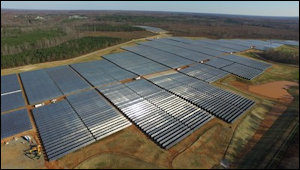
By Dick Hall-Sizemore
In light of recent denials by local governing bodies, there has been some skepticism expressed on this blog as to whether the Commonwealth could meet its goals on solar energy. Going against recent trends, however, has been the city of Chesapeake.
According to the Virginian-Pilot, the city council recently approved an application to build a 900-acre solar farm. This most recent approval about doubles the size of three previously-approved projects. It is estimated the project will cost $100 million. The company anticipates generating 118 megawatts, enough to power about 20,000 homes.
The land involved is now prime farmland. An interesting aspect of this project is that is an amalgamation of acreage from multiple owners.
The city of Chesapeake was created in 1963 through the merger of the City of South Norfolk and rural Norfolk County. It is the Commonwealth’s second largest city in area and still has an active rural, agricultural community. Over half the county, about 167 square miles, is zoned for agriculture and more than 30,000 acres are devoted to cropland. The city’s comprehensive plan calls for keeping an area of rural land that will be “a thriving working landscape, with programs that encourage new farming economy enterprises and rural industries that are compatible with the preserved rural character of the area.” The city even has an Open Space and Agricultural Preservation Program, where the government buys development rights from landowners.
It was against this backdrop that the debate over the solar panel project played out. (The Virginian-Pilot article described this debate in an earlier article.) Several planning commission and city council members expressed concern over the continued loss of farmland and the resultant changes in the nature of their community. However, as others pointed out, due to many factors, including the cost of buying and maintaining equipment, it is getting harder for anything other than a large-scale farming operation to make a profit. Furthermore, existing farmers are getting older and fewer young people want to go into farming. One member pointed out that proposals such as that for solar panels provide an alternative for farmers who no longer wish or are no longer able to farm their land. For several city council and planning commission members, it came down to, as one member put it, ““I happen to have a personal belief that individual landowners have a right to utilize their property within reason the way they want to.”
One of the landowners affected had been leasing his land to someone else to farm. In explaining his decision to enter into a contract with the solar panel company, he said, “For the first time in 51 years that I know of that we have been leasing … we can see a light where we can lock in our farm for 35 years, we know it will be secure and we will actually make a profit.” Another, whose family had farmed their land, or leased it to others for farming, since the 1940s, explained that farming doesn’t pay anymore and the project would prevent any future housing development there, which has been creeping up nearby and would put additional burden on roads and other services. “It’s time for a change,” he said.
My Soapbox. If Chesapeake officials hold any hope that comprehensive plans or buffer zones will keep development from gobbling up farmland, they only need look east to their next-door neighbor, Virginia Beach. I have been traveling for 18 years to Sandbridge in the traditionally agricultural area of Pungo in Virginia Beach. Each year, it seems, there is another field that is sprouting houses rather than corn or soybeans. Each year, the development creeps closer to the village of Pungo.
A large mass of solar panels is not attractive. But, neither is a bunch of large houses on tiny lots in a large open field. At least, the solar panels are better for the health of the soil over time. Furthermore, I can think of at least one agricultural-related enterprise that would be compatible with solar panels. That 900 acres would support an awful lot of native plants, which in turn could support millions of bees that could produce a lot of honey for anyone enterprising enough to put out and maintain the hives.
(I owe a debt to the Virginian-Pilot for the headline.)

Leave a Reply
You must be logged in to post a comment.